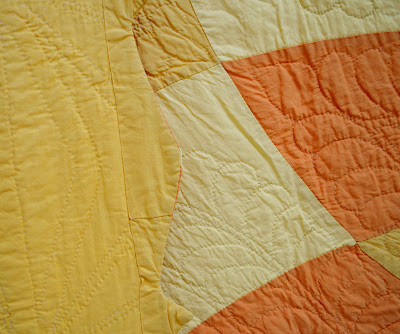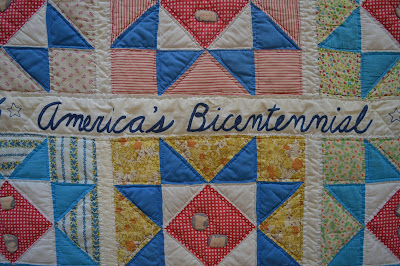This mid-19th century applique quilt had seen much better days when I found it in a vintage shop in Portland yesterday. It was folded in four on a tabletop with a chair standing on top of it. There was an old platter under the chair, a lamp base on top of the chair, and some kind of farming or gardening tool hanging from the ceiling, precariously mingling with the back of the chair and the lamp base.
"How can you tell the difference
between a cutter and a saver?"
The price tag on the quilt said "cut it up" since the condition was rough. So, let's talk about that. How do we know when it's OK to cut up an old quilt and when it's not? When you've handled and viewed a lot of quilts, you develop a sense.
 |
| Mary Kerr's "Twisted" special exhibit in Houston |
I was curious about how to convey this information to others, so thought I'd ask
Mary Kerr. Mary is well known for working with vintage materials, having authored books on the subject and displayed quilts in venues across the US, most recently at Quilt Festival in Houston.
 |
| Mary Kerr (left) and Lori East (right) |
"How can you tell the difference between a cutter and a saver?" I asked.
"The difference is up to the owner really," said Mary. "How much work, time and space are you willing to put into an object? Can we learn from it? Can it be preserved?"
 |
| the quilt was this way when I bought it, but worth saving |
I liked Mary's answer because it considered a variety of potential outcomes for the quilt. It could be restored. It could be a study piece, or it could be material for a project. Looking at the photo of my quilt, she added, "In my world this is a saver because of the rarity of design and the quality of the appliqué. It is lucky you found it."
 |
| "New York Beauty" from the 1860s, worth saving! |
Is there a good way to know what's unusual and worth saving and what is not? How do I know? The answer is pretty simple. I look at a lot of quilts, and have for decades.
Here's a good exercise: go to eBay, search for "antique quilt" and page through the results. You'll start to see trends, similarities, even homogeniety: lots of quilts in certain patterns from specific periods.
The Double Wedding Ring in this auction listing is a good example of a potential cutter. It is probably in good enough condition to save, but it's not rare. There were many Double Wedding Rings made with white backgrounds, but there's something else about this quilt. It's mass-produced, most likely in China in the 1990s. I've seen a lot of them. One dead giveaway is the "knife-edge" finish, but there may also be a separation of the seam where the tag once was.
 |
| 1840s crib quilt, worth saving! |
 |
| Siobhan Furgurson's quilt top, made after the original rescue quilt |
You will also see quilts that make you stop, look, and say to yourself, "That's different!" and that's exactly the type of quilt I love, regardless of condition. Many years ago I bought an old crib quilt in poor condition with an unusual design, and my friend Siobhan Furgurson is working on a reproduction of it. The quilt was being sold as a cutter, but I thought it was far too unusual for that.
One final note: when in doubt, phone a friend. I've had several friends text me seeking advice about quilts found in vintage shops, and usually I can tell them a little more about it without much effort. There are many people who can help. So, look for what's unusual, and what's not, and when in doubt phone a friend when asking yourself if a quilt is a cutter or a saver.


























































































